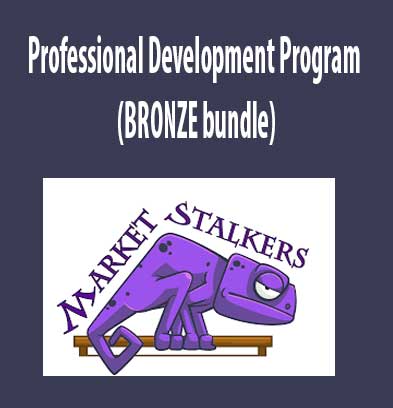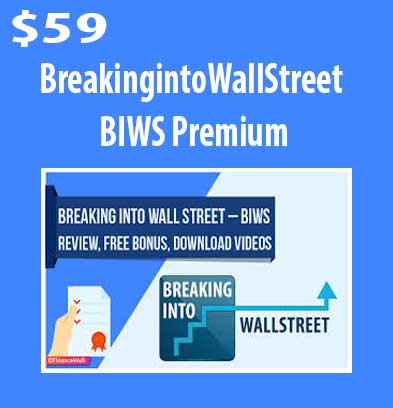Breaking Into Wall Street – The Ultimate Real Estate Financial Modeling Course
Description
Breaking Into Wall Street – The Ultimate Real Estate Financial Modeling Course review, Breaking Into Wall Street – The Ultimate Real Estate Financial Modeling Course download, Breaking Into Wall Street – The Ultimate Real Estate Financial Modeling Course free
Breaking Into Wall Street – The Ultimate Real Estate Financial Modeling Course
Here’s How to Master Real Estate
Financial Modeling, Learn REITs Like a Pro, Dominate Your Interviews, and
Fast-Track Your Way to Top Bonuses and Exit Opportunities
Includes a Quick-Start Pathway for Fast Results in 48 Hours – and a Parallel Advanced Pathway for In-Depth Mastery
- Get a crash course on the most important topics in Real Estate Financial Modeling via 8 separate 30-minute, 60-minute, and 90-minute real-life case studies.
- Skip the boring textbooks and theory – you can finish these case studies in a weekend and get up to speed in a fraction of the normal time required.
- Extend your knowledge beyond the crash course with 9 longer, 2-to-4-hour modeling tests that include more complex Excel formulas, case study prompts, and investment recommendations. These cases prepare you for the job itself as well as more advanced interviews.
- Understand the industry by doing – the best way to “learn the lingo” is by completing exercises that require you to implement “the lingo” in Excel.
- Master the concepts in no time with 300+ pages of written guides to individual properties and REITs that lay out the most important points. These guides include hundreds of interview questions and answers, and they’re the fastest way to review and refresh your knowledge.
- Test yourself with 126+ practice quiz questions at the end of the course. Pass these, and you’ll know you belong in the room come interview time.
There are a lot of “real estate financial modeling courses” out there, but most courses and books make 3 big mistakes:
Their models and examples are too complex and convoluted; no one has time to review a 5,673-row Excel file that took 412 hours to build.
- Their materials are not based on real-life case studies, but on the author’s imaginary view of what’s useful.
- They don’t help you to prepare efficiently. Yes, it’s nice to have 571 Excel files and 142 hours of video… but what if you only have 1 week, 2 days, or 4 hours to prepare for your interview?
Gain an Unfair Advantage by Quickly Conquering the
Two Topics That Matter Most in Any Real Estate Interview:
When you cut away all the nonsense, two topics matter more than anything else in any real estate interview:
- Your interest in real estate and knowledge of the industry. You must be able to discuss real estate trends, industry norms, and deal analysis fluently to win offers. If the interviewer asks you to describe a property or real estate deal that interests you, and you can’t think of anything, the interview’s over.
- Your ability to answer technical questions competently, complete modeling tests, and prove that you can do the work. Technical knowledge is required to win offers. If you can’t explain concepts such as Cap Rates, NOI, TIs, LCs, and different lease types, you’re finished. And if you can’t complete Excel models for acquisition, development, and renovation deals, why even bother stepping into the interview room?
Our Real Estate Financial Modeling Course is designed around these two critical topics.
Yes, there’s a lot of other stuff in here – overview presentations, quizzes, data gathering, sample investment recommendations, and more.
But if you answer questions in these two categories like a pro, the rest is icing on the cake.
Highlights of the Real Estate Financial Modeling
Course Include:
- The Quick Start Guide gives you study plans for a few hours up to a week or more, so you know what to focus on with limited time. If you have more time, great – but get the fundamentals right first!
- Understand Industry Lingo and What Real Estate is “All About”: Quick overview lessons help you get up to speed about the main types of properties, deals, and financing structures, and avoid days of wasted time going down the “Google random terminology endlessly” rabbit hole.
- Translate Case Study Instructions into Excel: Many courses provide Excel models and templates, but no one ever explains the true challenge of real estate case studies: How to translate written instructions and questions into Excel models – which is why we focus on it. And, of course, we show you how to complete those models and use them to answer the case study questions.
- Get Up to Speed Quickly on REIT Accounting and Valuation: We cut through all the junk online – the confusing, bloated information from random 15-year-old contributors – and spell out exactly how accounting, the financial statements, valuation, and M&A and LBO modeling differ for REITs. That also includes differences between U.S. GAAP and IFRS (good luck finding this explained anywhere else) and between REITs that own different property types.
- Learn Both Debt and Equity Analysis: Most courses and textbooks present equity analysis for properties and REITs, but stop short of including debt. This seems bizaare to us since nearly all real estate deals and companies involve debt – so we cover the whole spectrum and walk you through how to analyze debt deals, calculate credit stats and ratios, and answer credit questions in every case study in this course.
- Quickly Review the Key Points with Comprehensive Written Guides: There’s no substitute for doing the work and completing the case studies in this course, but if you just need a quick review, the written summaries will get you up to speed on the main concepts – fast.
- Practice Making and Writing Investment Recommendations: You’ll learn how to summarize the output of models for both individual properties and REITs and present investment recommendations – including clear yes/no decisions, qualitative and quantitative support for your decision, risk factors, and how to mitigate the risk. You’ll use these concepts every day on the job, and also in more advanced interviews.
- Learn Both “Quick and Dirty” and More Complex Models: If you only have 30-60 minutes to analyze a deal, no problem – there are models and examples for that scenario. But if you have several hours or days, there are more complex examples suited to in-depth analysis.
But… There Are Some Topics This Course Doesn’t Cover,
So It May Not Be for You!
We believe in radical transparency, so I don’t want to mislead you about what this course can do for you.
We focus on individual properties and real estate investment trusts (REITs).
Our goal is to prepare you efficiently for Excel-based case studies and interviews and get you up to speed on the job quickly.
As a result, we specifically exclude certain topics:
- This Course Does NOT Cover Excel Shortcuts or Basic Knowledge of Accounting and Finance: You must already know these topics to complete this course. If you do not, you should register for our Excel & VBA course or our Finanical Modeling Mastery course first. Here’s a simple test: Do you know what PV, NPV, and IRR mean? And could you write an INDEX/MATCH function to retrieve data in Excel? If not, start with one of these courses.
- This Course Does NOT Cover Every Single Combination of Models, Property Types, and REITs: Our goal is efficiency, not bells and whistles. We do cover a wide variety of companies, properties, and deals, but we do not attempt to teach all 5,413 possible combinations of property types, sub-industries, and geographies.
- This Course Does NOT Cover ARGUS and Other Non-Excel-Based Software: Yes, ARGUS and other real estate-specific software can be very useful, but it’s not our focus. You will learn how to use the output from these programs in Excel, and you will learn how to replicate the functionality of these programs in Excel, but you won’t get tutorials on these programs. It’s a whole separate topic that would require another full-length course.
- This Course Does NOT Cover Non-Property and Non-REIT Analysis: We do not teach private equity fund modeling (how entire investment funds, not individual properties, operate), nor do we cover gaming/lodging/homebuilding companies, real estate operating companies, or commercial mortgage-backed securities (CMBS). If we did, this course would be 200 hours long, and no one would ever complete it.
If you are interested in one of the topics above, you should look at offerings from other training providers.
But if you want the most effective and efficient preparation for real estate interviews, Excel-based case studies, and the job itself, this is the course for you.
Take a Look
Module 1: Real Estate Overview and Short Case Studies/Modeling Tests
In this module, you will get an introduction to Real Estate Financial Modeling, and you’ll practice key skills with short case studies/modeling tests across the main property and deal types.
Then, you’ll move into the real estate investment trust (REIT) lessons and learn how accounting, the financial statements, and valuation all differ.
These case studies are all short (30, 60, or 90 minutes) so you can get results and practice your financial modeling skills without needlessly complicated models or documents.
If you have limited time to prepare, you can complete this module in a weekend and feel confident and prepared for your interview by Monday morning.
- 6 Case Studies on Individual Properties: These include 2 office/retail acquisitions, an industrial development, a hotel acquisition/renovation, a pre-sold condominium development, and a multifamily acquisition. They range from 30 minutes to 90 minutes of completion time, and each one has a full video tutorial walk-through and written answers.
- 2 Case Studies on Real Estate Investment Trusts (REITs): These 90-minute case studies cover a U.S.-based REIT (Park Hotels) and a European REIT (Inmobiliaria Colonial SOCIMI), and they teach you how to project the three statements and value REITs with a DCF, DDM, NAV, and comparables. Each case study has accompanying video tutorials and written answers.
- 4 Overview Lessons: These video lessons and slides explain the main property and deal types and walk you through accounting, financial statement analysis, and valuation for REITs, including differences under U.S. GAAP and IFRS.
Module 2: 4-Hour Office Development Modeling Test (100 Bishopsgate)
In this module, you will complete a 4-hour real estate development modeling test for an office property in the City of London (100 Bishopsgate). You will expand on the simplified 90-minute version in the introductory module and build in support for a monthly schedule with flexible refinancing and exit dates and multiple scenarios.
You will also add support for tenants with different lease types, calculate returns to both equity and mezzanine investors, build a mixed IRR/multiple-based waterfall schedule, and add support for the Lookback Provision using VBA code.
Finally, you’ll answer the case study questions, make an investment recommendation for each investor group, quantify the risk factors, and explain how to mitigate the main risks.
10 Step-by-Step Lessons: These video tutorials walk you through how to complete the model efficiently and answer the case study questions, including how to make investment recommendations.
Waterfall Returns Schedule with Mixed IRR and Multiple-Based Tiers: You’ll learn how to create a variation of the standard waterfall returns schedule and how to split up the cash flows based on the property’s performance.
Brief VBA Tutorial: You’ll learn how to use VBA to add support for a “Lookback” function that evaluates the deal’s performance and then re-distributes the proceeds once the overall IRR is known at the end of the deal.
Module 3: 2-Hour Hotel Acquisition & Renovation Modeling Test (Jumeirah Beach Hotel)
In this case study, you’ll complete a 2-hour hotel acquisition and renovation modeling test based on a 5-star resort in Dubai, the Jumeirah Beach Hotel.
You’ll start by setting up assumptions for different market and operational scenarios, including Base, Upside, and Downside cases and Independent vs. Franchise cases, and you’ll use them to build a Pro-Forma for the property.
Then, you’ll set up the acquisition, exit, and financing assumptions, project the Debt service, calculate returns to equity investors, and set up sensitivity tables to analyze the deal outcome under varied assumptions.
Finally, you’ll make an investment recommendation, identify the key risk factors and explain how to mitigate them, and comment on the Independent vs. Franchise choice and the terms of the Permanent Loans.
6 Step-by-Step Lessons: In these video tutorials, you’ll learn how to set up and complete the model and how it expands on the simplified version in Module 1.
Support for 6 Different Scenarios: You’ll learn how to add support for multiple market and operational scenarios, including Base, Upside, and Downside and Independent vs. Franchise cases – and how key assumptions like the ADR and Occupancy Rate change in these cases.
Module 4: 3-Hour Multifamily Acquisition & Credit Case Study (The Lyric)
In this case study, you will build a multifamily acquisition and credit analysis model and make an investment recommendation on the Senior Loan, Mezzanine, or Preferred Equity used to fund the property.
You’ll start by building a standard Pro-Forma for The Lyric, a 234-unit multifamily property in Seattle, and you’ll add support for the acquisition, exit, and debt service, as well as the equity returns calculations.
Then, you’ll calculate the returns and recovery percentages for the lender groups in different scenarios and exit dates, and you’ll create sensitivities to further “stress test” the deal.
Finally, you will build a DCF to value the property, evaluate comparable properties and a Replacement Cost analysis, and answer case study questions about the debt and equity, the operating assumptions, the risk factors, and the valuation.
9 Step-by-Step Lessons: In these video tutorials, you’ll extend the multifamily acquisition model from Module 1 and add credit analysis and valuation sections, as well as multiple scenarios and more complex financing assumptions.
Credit Analysis: You’ll learn how to tweak a standard real estate model and add credit features, such as recovery and IRR analysis, as well as support for prepayment penalties, equity grants, interest-only periods, and interest rate floors and spreads.
Valuation/DCF Analysis: You’ll use data from comparable properties and recent property sales and build a DCF analysis to draw conclusions about the purchase price.
Module 5: 4-Hour Office/Retail Acquisition & Renovation Modeling Test (45 Milk Street)
In this case study, you will build an acquisition and renovation model for a mixed-use office/retail property and make investment recommendations for the Limited Partners, General Partners, Senior Lenders, and Mezzanine Investors.
You’ll start by setting up the transaction assumptions for 45 Milk Street, a 61,000-square-foot property in Boston, and then you’ll build a monthly and annual Pro-Forma that supports different lease types, start dates, and expiration dates, including Percentage Rent leases.
Then, you’ll project the Debt Service, including a TI/LC/CapEx Holdback released on a monthly basis, and you’ll calculate the returns to each investor and lender group.
In the Waterfall Returns Schedule, you will build in support for Preferred and Catch-Up Returns, and you’ll create sensitivity tables to analyze different outcomes.
Finally, you’ll use the model to make an investment recommendation for each group and explain how to mitigate the risk factors – or, for negative recommendations, what must change for the deal to work.
10 Step-by-Step Lessons: You’ll learn to combine elements of the office development model and the hotel acquisition/renovation model in this set of video tutorials.
Replicate ARGUS in Excel: You’ll create a monthly tenant-by-tenant schedule that replicates much of the functionality of ARGUS in Excel (with certain constraints) – including support for Loss to Lease, Concessions & Free Rent, Absorption& Turnover Vacancy, Tenant Improvements, Leasing Commissions, Expense Reimbursements, General Vacancy, Percentage Rent, and more.
Alternate Waterfall Schedule: You’ll create a waterfall schedule with a Preferred and Catch-Up Return for different investor groups, and you’ll understand how this factors into the investment recommendation.
Module 6: 2-Hour Pre-Sold Condo Development Modeling Test (Heritage Cyrela)
In this case study, you will build a condo development model for the Heritage Cyrela, a super-high-end luxury complex in São Paulo. You will then use the model to make investment recommendations for the Limited Partners and Developers and identify the key risk factors in the deal.
You’ll start by setting up the transaction assumptions and the construction timeline, including the monthly pre-sales of condo units in each phase and the start and end of the construction period.
Then, you’ll project Gross Sales based on initial, construction-end, and final deposits, and you’ll forecast the Hard Costs, Soft Costs, FF&E and Move-In Costs, and Land Acquisition Costs.
You’ll use this monthly cash flow model to project Equity and Debt draws, interest, and principal repayment, and then you’ll build a Waterfall Returns Schedule with a Preferred Return, Catch-Up Return, and tiers based on a mix of IRRs and equity multiples.
Finally, you’ll create an annual summary, Sources & Uses schedule, and sensitivity tables to summarize everything and answer the case study questions.
7 Step-by-Step Lessons: You will expand on the simplified condo development model from Module 1 and add additional phases and sales triggers, as well as a more complex Debt/Equity treatment. These video-based lessons walk you through the whole process.
More Complex Waterfall: You will learn how to build a waterfall returns schedule with support for a Preferred Return to the 3rd Party Investors, followed by a Catch-Up Return to the Developers, followed by cash flow splits that are based on a mix of IRRs and equity multiples – and you will do all this on a monthly basis.
Module 7: 4-Hour (or 1-Week) REIT Valuation Modeling Test (AvalonBay)
In this case study, you will build a 3-statement model and valuation for AvalonBay, a leading U.S.-based multifamily REIT. You will then use the model to create a hedge fund/asset management stock pitch, an equity research report, and an investment banking pitch book for the company.
You’ll start by projecting the company’s developments, redevelopments, acquisitions, dispositions, and unconsolidated real estate (equity investments), and you will use these segment-level projections to build a 3-statement projection model.
Then, you will value the company using a Net Asset Value (NAV) Model, Comparable Public Companies and Precedent Transactions, and a Discounted Cash Flow (DCF) Analysis based on a 10-year projection period. You’ll also get practice finding the data and adjusting the numbers based on disclosures in SEC filings.
You’ll then summarize the results of this valuation and use it to outline a stock pitch for the company, including the investment thesis, catalysts, risk factors, and ways to hedge against the main risks. Finally, you’ll tweak this pitch to create an equity research report and an investment banking pitch book with a debt vs. equity recommendation for the company’s financing requirements.
If you complete only the model here, it’s a 4-hour case study. If you also draft the stock pitch and the other documents for a more in-depth exercise, it’s closer to a 1-week case study.
20 Step-by-Step Lessons: Learn how to expand on the REIT models from Module 1 and add additional operating assumptions, gather and adjust data for the comparables, and support multiple scenarios; you’ll also learn how to handle JVs and Equity Investments and how a more complex NAV Model works. These videos explain the entire process.
Hedge Fund Stock Pitch: You’ll learn how to outline and draft a short stock pitch in both written (Word) and slide (PowerPoint) format, and you’ll understand how to craft an investment thesis and research catalysts, risk factors, and ways to mitigate the risk for REITs.
Equity Research Report: You’ll learn how to tweak the stock pitch to create an equity research report that presents similar ideas, but changes the tone, focus, and presentation for use in a different context.
Investment Banking Pitch Book: You’ll learn how to make a Debt vs. Equity recommendation for AvalonBay, and you’ll get an example of a short pitch book presentation you can use to present your findings and argue for a different financing mix.
Module 8: 2-Hour REIT Debt vs. Equity Case Study (SPH REIT)
In this case study, you’ll project the performance of individual properties for SPH REIT, a Singaporean retail REIT, on a half-year basis, and you’ll create a 3-statement model that supports the S$ 500 million acquisition of Seletar Mall, a new property, using Equity and Debt.
You will create Base, Downside, and Extreme Downside Cases based on market data, and you’ll use the different Rental Reversions, NPI Margins, and Cap Rates in those cases to assess the company’s credit stats and ratios (Gearing, Debt / EBITDA, EBITDA / Interest, and others).
Then, you’ll try different combinations of Debt and Equity until you find one that allows the company to achieve its targeted metrics and ratios (Distribution Yield > 5%, DPU Accretion >= 0%, Gearing <= 35%, and Interest Coverage >= 5.0x) across all the cases.
Finally, you’ll answer case study questions at the end, present your recommendation, explain the key risk factors and how to mitigate them, and examine other ways the company could change its capital structure to meet its targets.
6 Step-by-Step Lessons: You’ll learn how to create a half-year operating model for a REIT based on its individual properties, and how to incorporate scenarios and credit stats and ratios. These video-based lessons walk you through the whole process.
Data Gathering Exercises: Unlike in some of the other case studies, which give you explicit numbers, here you’ll have to review documents and market data and use your judgment to come up with appropriate growth rates, margins, and other assumptions; our tutorials explain this process.
Module 9: 3-Hour REIT M&A and Merger Model Case Study (Digital Realty / DuPont Fabros)
In this case study, you’ll complete a quarterly merger model and supplemental analysis for Digital Realty’s $5.8 billion acquisition of DuPont Fabros, and you’ll learn how purchase price allocation and the combination of the financial statements differ for REITs.
You’ll start by reviewing each company’s standalone quarterly projections and NAV models, and then you’ll set up the transaction assumptions, including the Sources & Uses and Purchase Price Allocation schedules, including new items such as Above- and Below-Market Lease Intangibles.
Then, you’ll combine and project the financial statements, calculate key metrics such as accretion/dilution for FFO and AFFO per unit & share, and analyze the credit profile of the combined entity.
Since most REIT M&A deals are 100% stock, the Contribution Analysis and Value Creation Analysis are especially important; you’ll complete both here and use them to draw conclusions about the deal terms, the seller’s valuation, and the potential risk factors in the deal.
Finally, you’ll answer the case study questions at the end, make a recommendation for or against the deal, and see how you might present your findings in a short presentation as well.
12 Step-by-Step Lessons: You’ll learn how to build a full 3-statement merger model for REITs, including key differences vs. M&A deals for normal companies, and you’ll add REIT-specific analysis and use the model to answer the case study questions.
Contribution and Value Creation Analyses: You’ll learn how to create REIT-specific analyses for M&A deals that are more meaningful than traditional accretion/dilution metrics, and you’ll assess the deal based on these methodologies.
Investment Banking Deal Recommendation Presentation: In the final lesson, you’ll get an example of a short presentation you can use to recommend for or against the deal, and you’ll learn how to use visual elements to strengthen your arguments.
Module 10: 2.5-Hour REIT Leveraged Buyout and LBO Model Case Study (Blackstone / Pure Industrial Real Estate Trust)
In this case study, you’ll analyze Blackstone’s $2.5 billion CAD leveraged buyout of Pure Industrial Real Estate Trust (PIRET) in Canada and make an investment recommendation for or against the deal.
You’ll start by learning about the key differences in REIT leveraged buyouts, and then you’ll set up the transaction assumptions, scenarios and drivers for the REIT’s same-store, acquisition, development, and disposition activity, and the full financial statement projections.
Then, you’ll add the Debt Schedule, examine the credit stats and ratios, and calculate the returns to all investor groups, including a management rollover, options pool, and multiple-based incentive fee for Ivanhoé Cambridge (the other equity investor in the deal).
Finally, you’ll set up sensitivity tables and use them to answer the case study questions and make an investment recommendation. The final, optional lesson will show you how to draft a 10-slide presentation with your findings.
11 Step-by-Step Lessons: These video tutorials will walk you through the process of building an LBO model for a REIT, including how to include operational scenarios and modify the normal Dividend and Debt/Equity assumptions.
Alternate Returns Calculations: You’ll learn how to link the exit multiples to prevailing Cap Rates, and how to factor in continual Dividends, a Management Options Pool, a Management Rollover, and an Incentive Fee for Ivanhoé Cambridge.
Investment Recommendation Presentation: The final lesson here gives you an example of an investment recommendation presentation you can use and re-use in other LBO case studies and private equity interviews.
Hear Directly from Customers Who Achieved Spectacular
RESULTS with BIWS Real Estate Modeling:
“All Models Are Comprehensive and Simple to Understand.”
So, What’s Your Investment in the
Real Estate Financial Modeling course?
To put this in context, let’s consider your Return on Investment in this course…
The pay for investment banking jobs varies from year to year, but it’s safe to say that even entry-level Analysts would make at least $140,000 – $160,000 USD right out of university.
At the MBA level, that climbs to $200,000 – $250,000 USD. And as you progress, your salary only gets higher and higher.
Compensation at commercial real estate (CRE) firms and CRE lending firms is lower, but it’s still at least $80,000 – $90,000 total at the entry level, rising to $175,000 – $300,000 in the mid-levels.
And in real estate private equity, you start in the $100,000 – $200,000 range and move up to the $500,000 – $1 million range at the upper levels.
By investing in this specialized program, you’re doing several things at the same time:
- Gaining extremely specialized knowledge in a field in which there is always high demand for people who know what they’re doing.
- Learning practical, real-world skills you can apply right now. No other Real Estate Modeling course on the planet has tutorials on stock pitches, equity research reports, and investment banking pitch books, or on how to draft investment recommendations for property deals, highlight the risk factors, and explain how to mitigate them.
- Differentiating yourself from other finance and real estate professionals and students at top schools – even those with the best academic pedigrees and the highest GPAs.
- Proving beyond a doubt to current or potential employers that you’re prepared to go “above and beyond” to be the best and get results… in other words, you’re exactly the type of person that banks, private equity firms, and real estate firms love to hire, reward, and promote.
So, the value you stand to receive is substantial.
And your investment? Just __biws_custom_info_Real_Estate_Modeling___Members_PRODUCT_PRICE for the entire program.
A Simple Choice…
If you are reading this right now, you’re serious about a career in commercial real estate, investment banking, real estate private equity, and related fields…
You know the importance of your first impression in that initial 30-minute interview and your performance in the interviews that follow.
Interview success can be the difference between a lucrative career at prestigious firms like Goldman Sachs, Morgan Stanley, KKR, and Blackstone… or the back office.
Sure… you could ‘wing it,’ hope for the best, and take a huge risk with your future, even though you know you are competing against some of the best and brightest…
OR
You could prepare to dominate your competition, gain an unfair advantage, and land one of the limited real estate opportunities available, by investing in the Real Estate Modeling course.
I know you will make the right choice so that you start landing six-figure job offers with the top banks, CRE firms, and private equity firms – places that just might make your friends a bit jealous when they hear about your success!
The Ultimate Real Estate Financial Modeling Course – BREAKING INTO WALL STREET, what is it included (Content proof: Watch here!)
- Module 0 Real Estate Modeling Study Plans and Quick Reference Guides
- Module 1 Real Estate Overview and Short Case StudiesModeling Tests
- Module 2 4-Hour Office Development Modeling Test (100 Bishopsgate)
- Module 3 2-Hour Hotel Acquisition & Renovation Modeling Test (Jumeirah Beach Hotel)
- Module 4 3-Hour Multifamily Acquisition and Credit Case Study (The Lyric)
- Module 5 4-Hour OfficeRetail Acquisition & Renovation Modeling Test (45 Milk Street)
- Module 6 2-Hour Pre-Sold Condo Development Modeling Test (Heritage Cyrela)
- Module 7 4-Hour (or 1-Week) REIT Valuation Modeling Test (AvalonBay)
- Module 8 2-Hour REIT Debt vs. Equity Case Study (SPH REIT)
- Module 9 3-Hour REIT M&A and Merger Model Case Study (Digital Realty DuPont Fabros)
- Module 10 2.5-Hour REIT Leveraged Buyout and LBO Model Case Study (Blackstone Pure Industrial Real Estate Trust)
- Module 11 Certification Quiz
Our Policies
A. Product Quality
We will provide GOOD quality of courses fast. If any issue, email: [email protected].
We sure that your problem will be support as soon as possible.
B. Digital Shipping Proceess
After your payment, we will review your payment, Then, we will send you PCLOUD LINK OF COURSES through email in 3 – 8 hours. If any issue, we will inform you as soon as possible.









Reviews
There are no reviews yet.